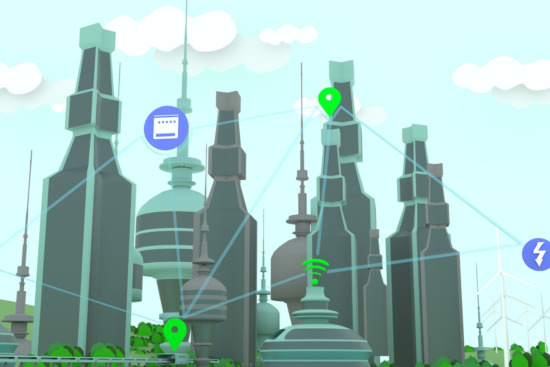As technology evolves, it continues to shape our lives in significant ways, improving efficiencies and transforming our experiences. One of the most profound applications of technology improvements is seen in the creation of Smart Cities. These highly-connected urban areas leverage the latest technology to improve the quality of life for residents, create sustainable environments, and offer new business opportunities.
The Benefits of Smart City Technology
In the realm of Smart Cities, technology serves as the cornerstone, revolutionizing the way we live, work, and interact within urban spaces. One of the standout features of this technological revolution is its capacity to collect and analyze vast amounts of data. This, in turn, enables smarter decision-making and promotes proactive urban management.
Imagine a city where data from sensors stationed throughout the area provides real-time information on diverse sectors. This could range from traffic flow and public safety to waste management and energy consumption. This real-time feed not only enhances operational efficiency but also enables city administrators to be agile in their response to urban dynamics.
Consider the daily commute of city dwellers. Real-time updates on traffic snarls or transit schedules could dramatically streamline their day, alleviating stress, and saving valuable time. Similarly, the quick response capabilities offered by data-driven insights can effectively mitigate risks, enhance safety, and ultimately elevate the city’s livability quotient.
In essence, the implementation of Smart City technology carries the promise of an urban landscape that is not just efficient, but also resilient and citizen-friendly. The seamless integration of technology into city infrastructure sets the stage for an urban life experience that is tuned to the rhythm of the 21st century.
Creating Sustainable Urban Environments
Technology advancements have given us the tools to dramatically reshape urban environments into sustainable spaces. Smart Cities are at the forefront of this shift, utilizing technology to efficiently monitor and manage energy usage, which directly contributes to lowering carbon footprints. Take, for instance, the development of smart grids. These intelligent systems distribute power with optimal efficiency, significantly reducing energy wastage.
Intelligent lighting systems present another shining example of this sustainable transition. Unlike traditional lighting, these systems adapt to changes in natural light conditions and the presence of pedestrians. As a result, energy conservation is inherently woven into the fabric of daily city life.
Harnessing the power of technology for the creation of sustainable urban environments doesn’t stop there. Smart Cities also employ data analytics to track waste production and recycling rates, facilitating the development of effective waste management strategies. By doing so, they contribute to creating cleaner, greener, and healthier cities.
Innovative water management is another essential component of sustainability in Smart Cities. Here, technology can be used to detect leaks in real-time, monitor usage, and promote water conservation, paving the way for responsible resource utilization.
Overall, the journey towards creating sustainable urban environments isn’t merely about managing resources more efficiently. It also involves designing cities that can withstand the challenges of the future. The fusion of technology and sustainability within Smart Cities holds the promise of resilient urban spaces that balance ecological concerns with the evolving needs of their inhabitants. As such, Smart Cities stand as a testament to how technology can be harnessed to create a sustainable urban future.
Innovations in Transportation Infrastructure
Advancements in transportation infrastructure, powered by Smart City technologies, are making significant strides in urban mobility. Real-time data, obtained from sensors throughout the city, is being used to recalibrate traffic light sequences. This advanced strategy can drastically reduce gridlock and improve the flow of traffic, making commutes smoother and quicker.
Moreover, public transport is being revolutionized by the integration of technology. Systems now can relay live updates on bus or train timings, drastically improving the commuter experience by enabling better planning and reducing wait times.
Another facet of the transportation transformation in Smart Cities is the inclusion of electric vehicles (EVs) and their corresponding charging stations into urban planning. This not only encourages the use of more sustainable means of transportation but also ensures that the necessary infrastructure is in place to support such initiatives.
The use of autonomous vehicles is yet another innovation being explored in the Smart City context. Through the use of advanced sensors and AI technology, these self-driving vehicles can navigate the city, further reducing traffic congestion and enhancing safety on the roads.
Each of these advancements presents a unified goal: making transportation in urban environments more efficient, sustainable, and user-friendly. By using technology to address transportation issues, Smart Cities are creating a more seamless urban living experience.
Business Opportunities in Smart Cities
In the ecosystem of Smart Cities, a myriad of business possibilities are burgeoning. Companies that are quick to adapt and innovate stand to benefit significantly from this rapid technological evolution. The wealth of data generated within these digitally-empowered urban environments can serve as a valuable resource for businesses, paving the way for innovation and enhanced service delivery.
Take, for example, enterprises operating in the IoT, AI, and Big Data sectors. These companies can provide the critical technological foundations, processing capabilities, and analytical tools that Smart Cities rely on. As urban environments become more connected, these businesses will have a pivotal role in shaping their technological landscape.
Meanwhile, the transport, energy, and healthcare sectors can harness the real-time data collected to refine their services. From optimizing energy distribution to predicting public transport schedules and advancing telehealth services, businesses can transform traditional models of operation, carving out unique value propositions.
Smart Cities also open up avenues for businesses focused on sustainability, ranging from renewable energy providers to waste management enterprises. By aligning with the green goals of these cities, these firms can contribute to urban resilience while also realizing economic growth.
In essence, the rise of Smart Cities ushers in a new age of opportunity for businesses. By leveraging technology and data, they can unlock fresh potential for growth, innovation, and service delivery, shaping the future of urban living while also contributing to their bottom line.
Empowering Citizen Engagement in Smart Cities
The rise of Smart Cities also presents a unique opportunity for residents to become more actively involved in their urban environments. Through technology, city dwellers now have the tools to interact directly with their city administrators. User-friendly mobile applications and digital platforms give citizens the power to voice their concerns, suggest improvements, or contribute ideas towards city planning initiatives. This allows for a more collaborative approach to city development, with decision-making processes being influenced not just by data, but also by the invaluable input from the city’s inhabitants. Such digital empowerment promotes a greater sense of community, as residents feel heard and see their feedback reflected in the urban changes. It fosters a sense of belonging and collective responsibility, where each citizen is an active stakeholder in the city’s progress. With these tech-enabled avenues for engagement, Smart Cities are essentially encouraging their residents to play a more participative role in shaping their urban landscape. This is much more than a smart use of technology – it’s a smart way of building cities around the needs and desires of the people who live in them.
Securing Smart Cities: Balancing Security and Accessibility
As urban landscapes evolve into digitally connected environments, the aspect of security becomes increasingly crucial. Smart Cities, with their rich troves of data, must ensure robust protection mechanisms to safeguard citizen privacy and prevent potential cyber threats. However, the challenge lies in achieving a symbiotic relationship between stringent security measures and ease of accessibility for city dwellers.
One of the best examples of a Smart City in action is Singapore. This bustling metropolis has successfully harnessed technology to enhance the quality of life for its residents. Using an extensive network of sensors and cameras, Singapore’s Smart Nation program collects a vast array of data on everything from cleanliness to crowd density. This real-time data is analyzed to improve various aspects of urban life, such as traffic, waste management, and even elderly care. In transportation, for instance, Singapore uses technology to provide real-time updates on traffic conditions, helping commuters plan their routes more efficiently. The city-state has also implemented a Smart Home initiative, where residents can monitor their energy usage and reduce unnecessary consumption. Moreover, Singapore has launched a ‘Virtual Singapore’ project, a dynamic 3D model of the city that enables urban planners to simulate and test new solutions in a virtual environment before implementing them in the real world. Through these and many other initiatives, Singapore exemplifies how cities can effectively use technology to enhance urban efficiency, sustainability, and livability.








